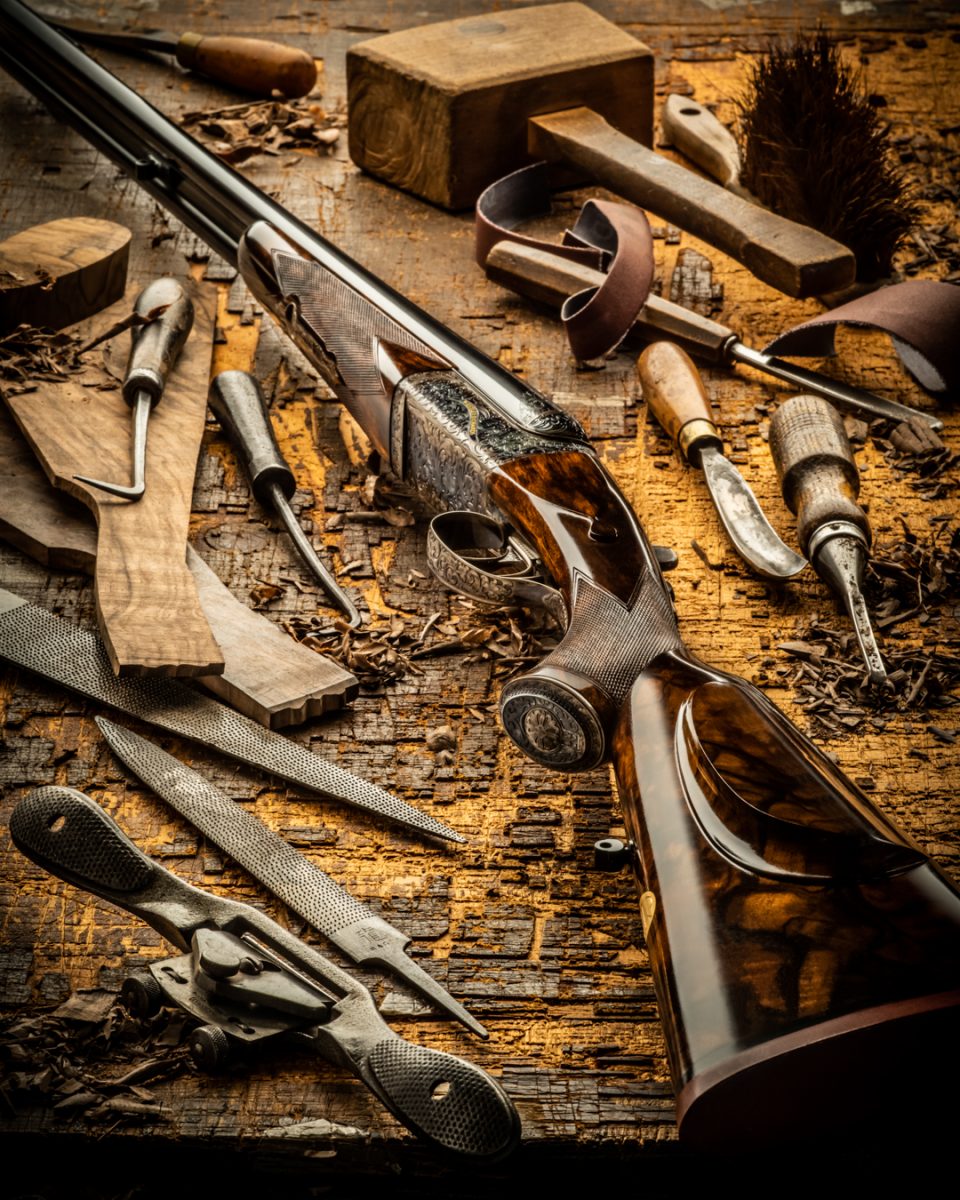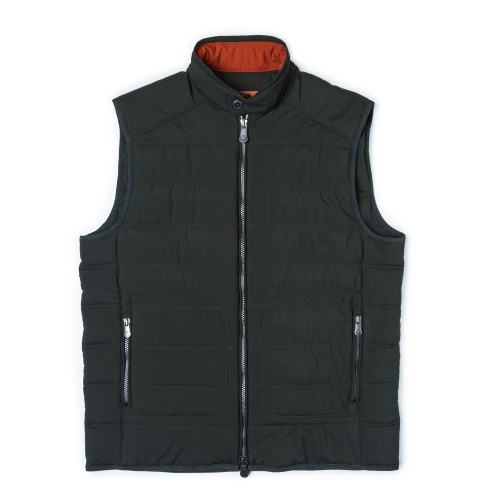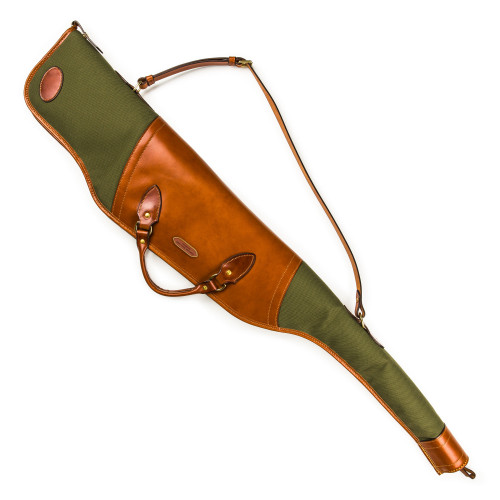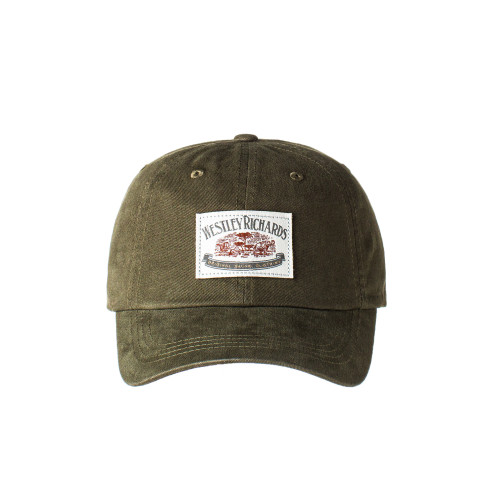It is a Modele-de-Luxe, the name Westley Richards has used for its extra-finish guns and rifles for over a century. Quite why so many British gunmakers used French to describe their highest quality products is a reason lost to time. Perhaps, like the fashion for naming gun models in Latin in the last quarter of the 19th century, it just sounds more sophisticated.
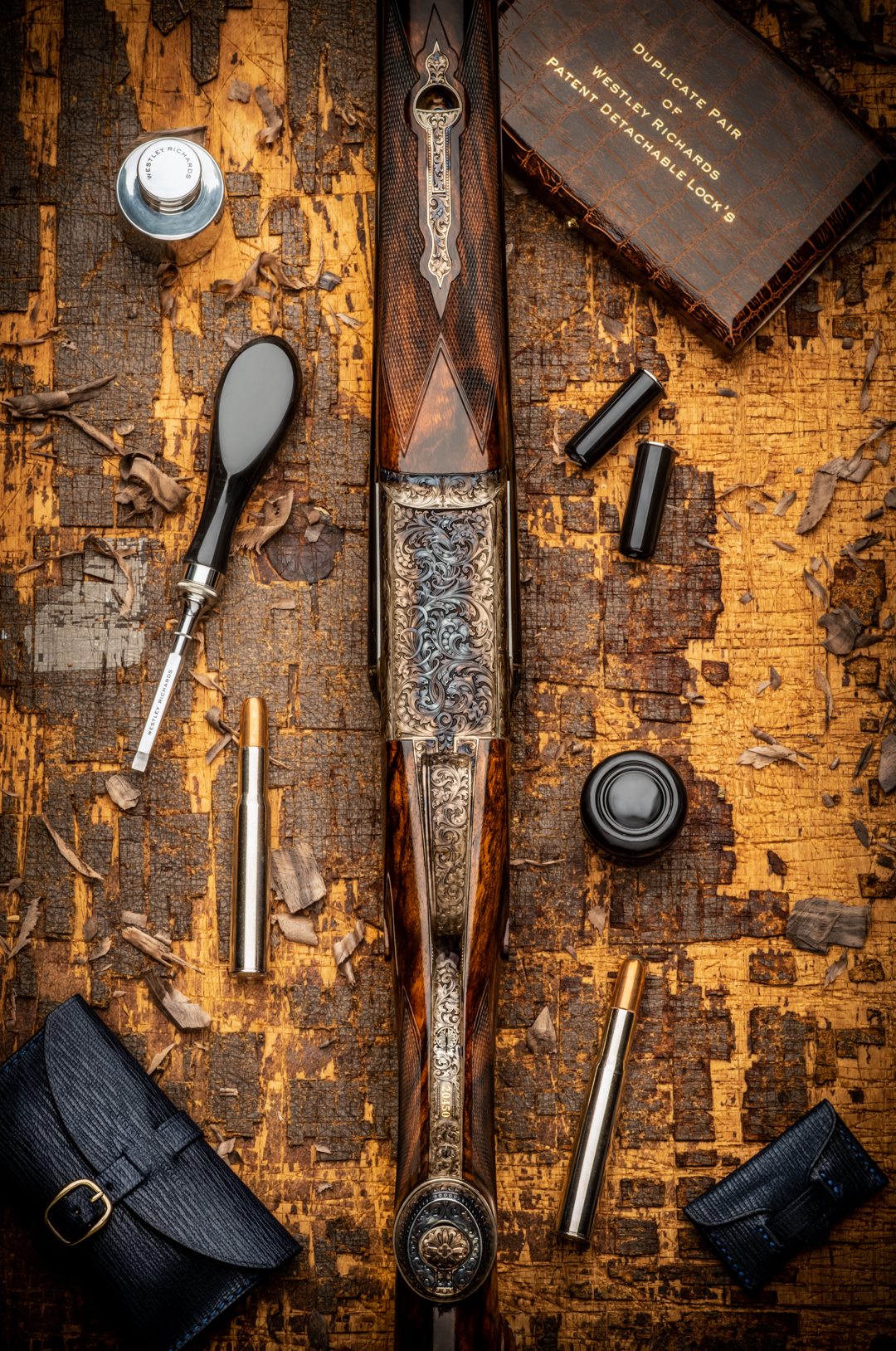
Perhaps the first thing a customer thinks about when he decides to order a new rifle is the cartridge. After-all, the rifle is primarily a means of delivering the contents of a cartridge to its final destination, if one is to be reductive.
This customer ordered a .416 but not the .416 readers will immediately bring to mind when the number is mentioned. That would be the .416 Rigby, which first arrived on the scene in 1911, as a magazine rifle cartridge for big game.
John 'Pondoro' Taylor, perhaps the best commentator on the effectiveness (or otherwise) of a huge range of cartridges on Africa's game animals in the immediate pre and post-war eras was effusive in his praise of the .416 but lamented that it was unsuited to double rifle application because of the lack of a rim for straightforward extraction or ejection.
Sportsmen had to wait until 1996, long after 'Pondoro' had died (in 1969), before the industry (in the form of Krieghoff) presented them with a rimmed version of the classic .416. They called it the .500/.416 Nitro Express (3 1/4").
That cartridge is what this rifle chambers.
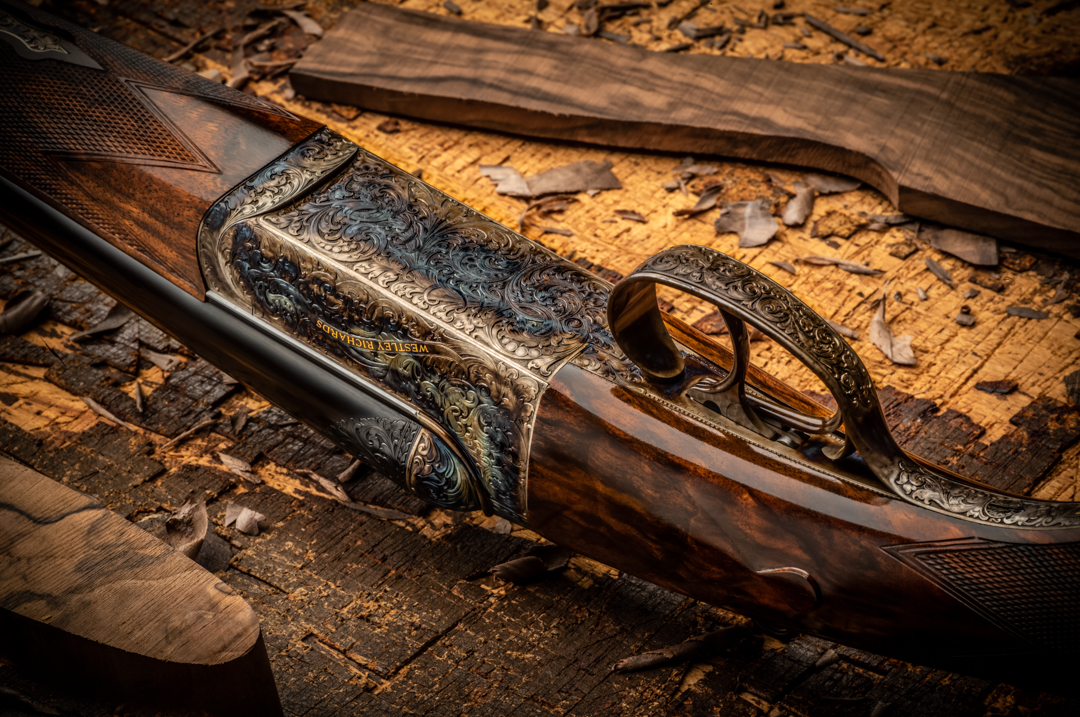
The .500/.416 pushes a 410-grain bullet at up to 2,325 fps, making 5,000 ft/lbs of energy and it will tackle anything in Africa, including elephant, comfortably.
It is actually a user-friendly cartridge in smaller ways too; the long case, with a long neck, has ample capacity, grips the bullet well and is easy to hand-feed into the chamber in a hurry. Because of its relatively civilised recoil and muzzle flip, it can be chambered in a rifle of around 11lbs to create a portable and pointable combination that promotes fast recovery and lessens the time needed to get off a second shot. The rifle shown here is actually 10lbs 8oz, coincidentally the same weight to which we build our modern .470 NE doubles.
It effectively replicates the .416 Rigby in a double rifle without complicating the extraction of spent cases. We regulated this particular rifle for the popular Norma PH 410-grain, soft-nose and solid rounds, which are well respected and readily available.
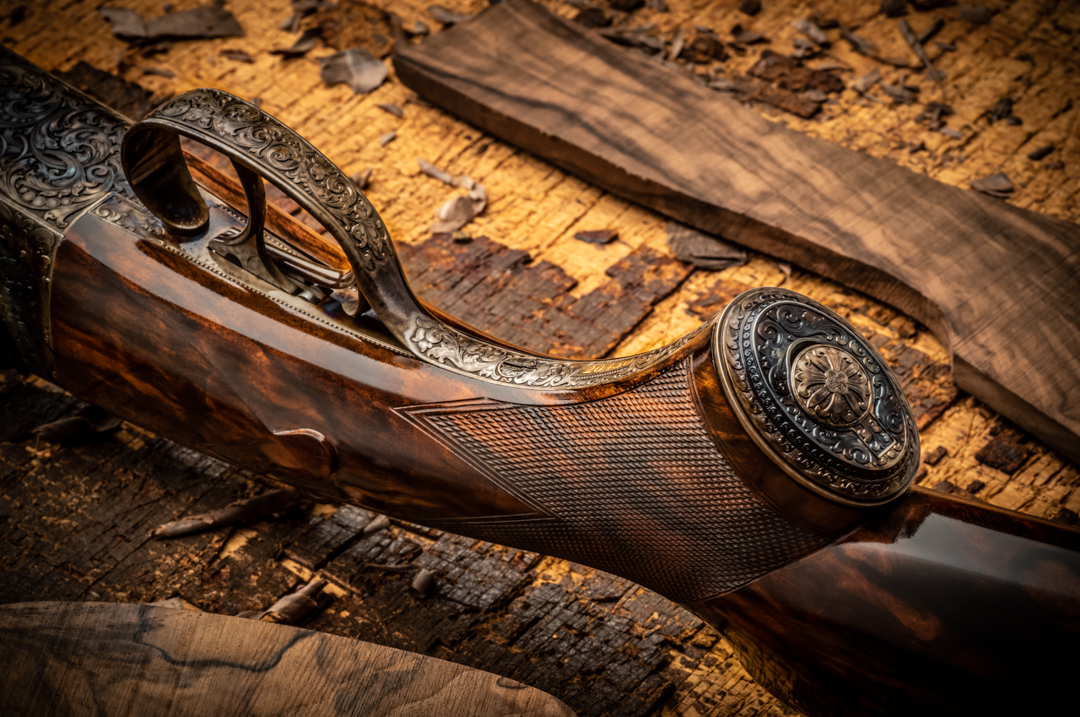
The recognisable elements of the build will be familiar to Westley Richards aficionados. The client opted for a traditional square back to the action, rather than a 'fancy back' despite it being a Modele-de-Luxe. The exhibition grade walnut stock has a sling-eye embedded, a grip-cap, with trap for spare strikers, and is finished with a dark red Silver's hard-rubber recoil pad.
The action is our signature 'hand detachable lock' patented in 1897 by our then managing director, Leslie B. Taylor. This has become widely known as the 'drop-lock' and many consider it to be the best all-round choice for overseas expeditions, especially those heading to remote and inhospitable places for long periods of time. The safety is manual, removing one operation from the cycle, which is crucial should a fast re-load and fire be required.
The origin of the drop-lock is the 1875 Anson & Deeley patent (also created by Westley Richards), which revolutionised double-gun design at time when 95% of double rifle and shotgun production featured weapons with exposed hammers. The success of the 'hammerless' (it still has hammers but they are inside the action body) Anson & Deeley led to the modification we see here, with the lockwork replicated but mounted on a steel plate and inserted from below, via a hinged floor-plate.
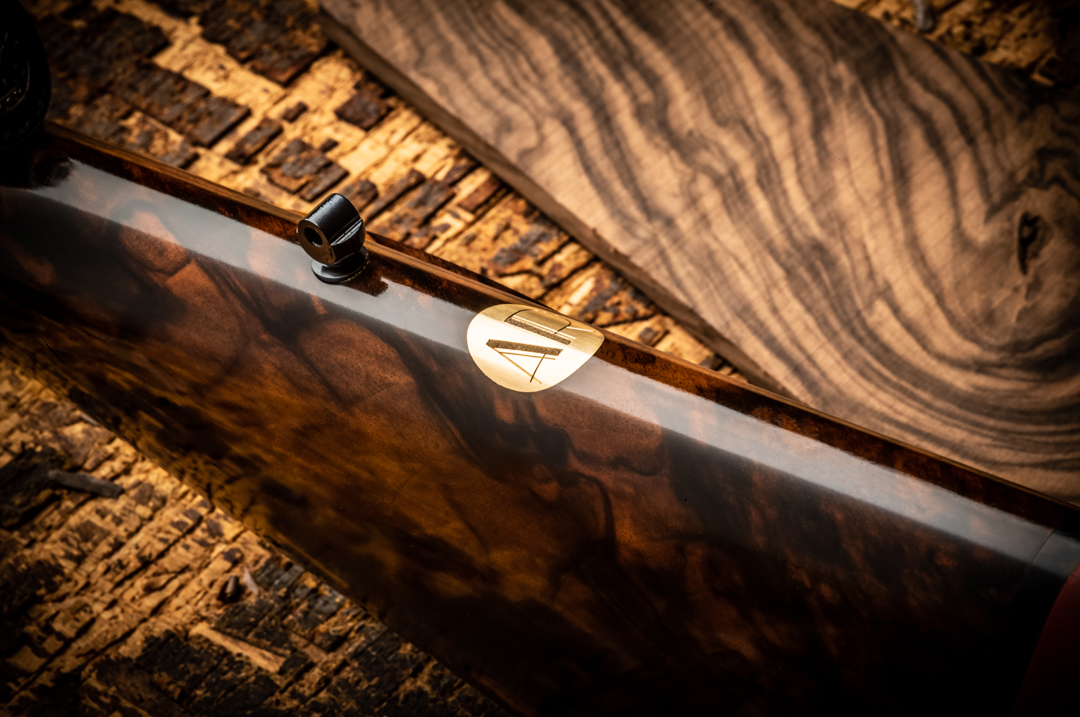
The advantage that the drop-lock confers, is instant accessibility to the locks. Without the use of any tools at all, either lock can be removed in seconds. A sidelock requires the correct turn screw and a modicum of gun knowledge to take off and replace each lock. A fixed lock Anson & Deeley gun is significantly more complicated to dis-assemble and re-assemble. So, the drop-lock is the clear winner in that regard.
It may be argued that sportsmen should leave the gun-smithing to their gun-smith, which is usually sound advice. However, if you are hunting in Africa and drop your rifle in a swamp, your gunsmith won't be there to strip and clean it for you. That being the case, a quick finger and thumb operation to take out the key mechanism, clean it, dry it and oil it, then pop it back into place as a very attractive solution.
Should a spring break (admittedly a very rare occurrence), the spare set of locks provided with the rifle can be slipped into place as easily as replacing the cartridge in an ink pen and hunting can continue uninterrupted.
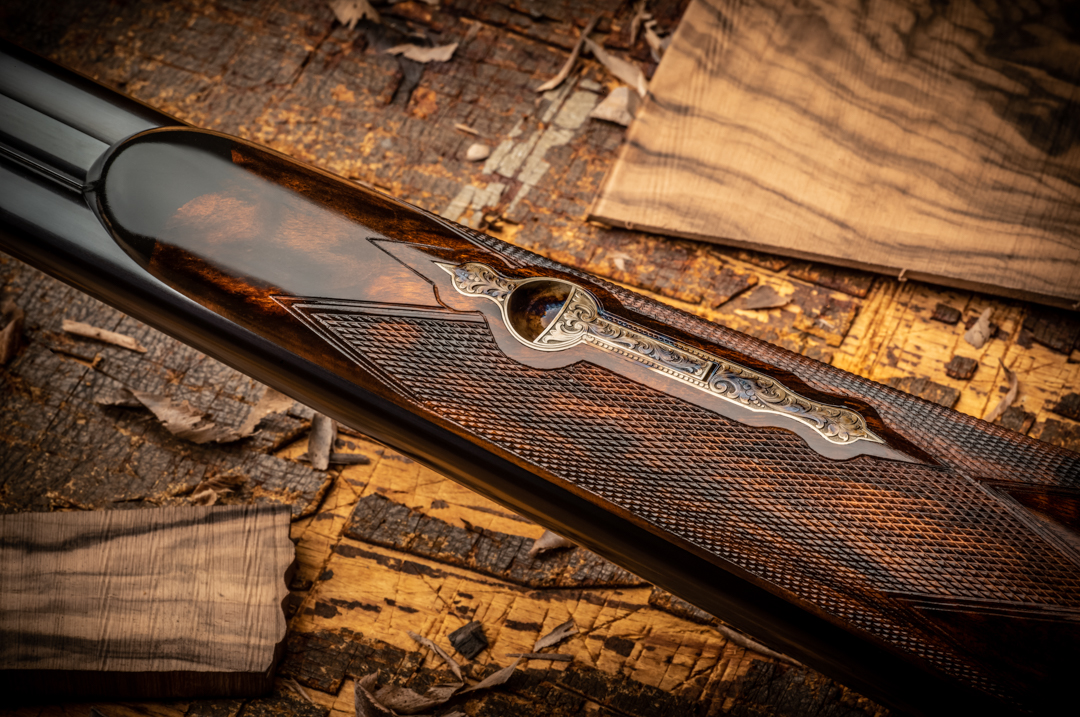
The rifle in its entirety, can be seen in the photograph below in its dis-assembled state. As befits a best rifle like this, it is French-fitted into a bespoke leather case with blue leather lining and compartments for tools and accessories, including the green canvas and mid-tan hide shoulder strap.
While being a totally practical rifle, built on the best available action and chambered for an immensely capable cartridge, as a Modele-de-Luxe, this is close to the highest expression of bespoke rifle-making it is possible to create today.
The beautifully marbled deep orange and black of the walnut, with its flawlessly-glossy, hand-rubbed oil finish, blends perfectly with the traditional case-colour hardening and the deep-black of the barrels.
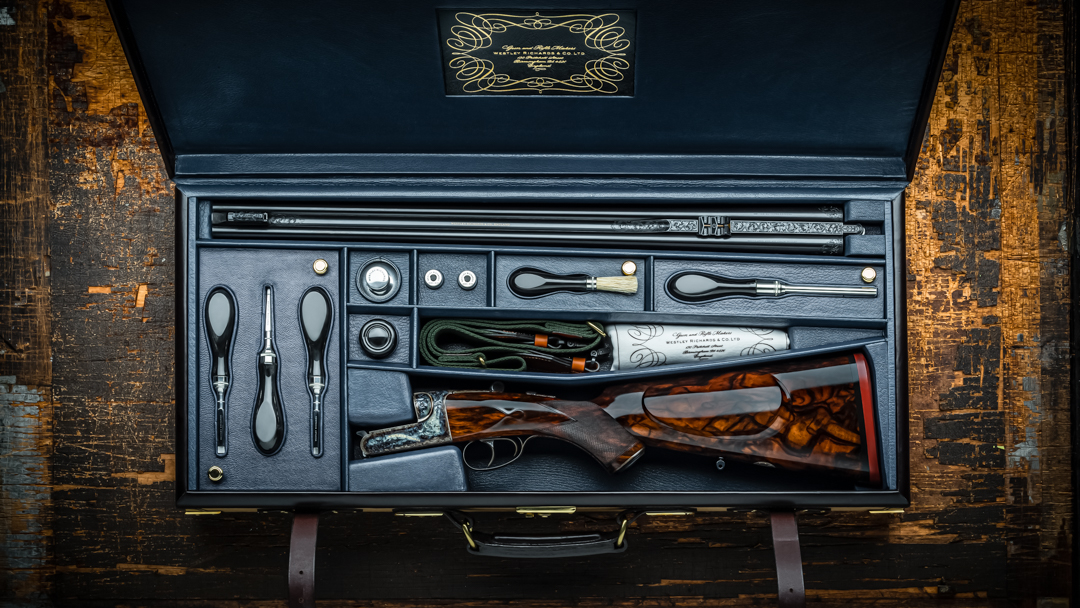
The barrels provide the contrast and a clue to where this particular rifle differs in finish from the usual.
Most rifles and shotguns will have blacked furniture. By that term, gunmakers mean the metalwork other than the action. Here, it is all case-hardened. Look at the trigger plate, the forend iron, the Deeley forend release catch, the guard, the top-lever and the bottom-plate.
They all continue with the theme of vibrant case-colour-hardening, created by heating the steel parts with a mixture of leather, bone and other packing materials until they impart a hardened skin to the surface, which is distinguished by the colours swirling in the unique patterns each gun absorbs.
Case hardening has practical benefits; as well as imparting beauty to the steel, it seals the grain and deters rust and tarnish from attacking the steel. It also makes the engraving more resistant to wear.
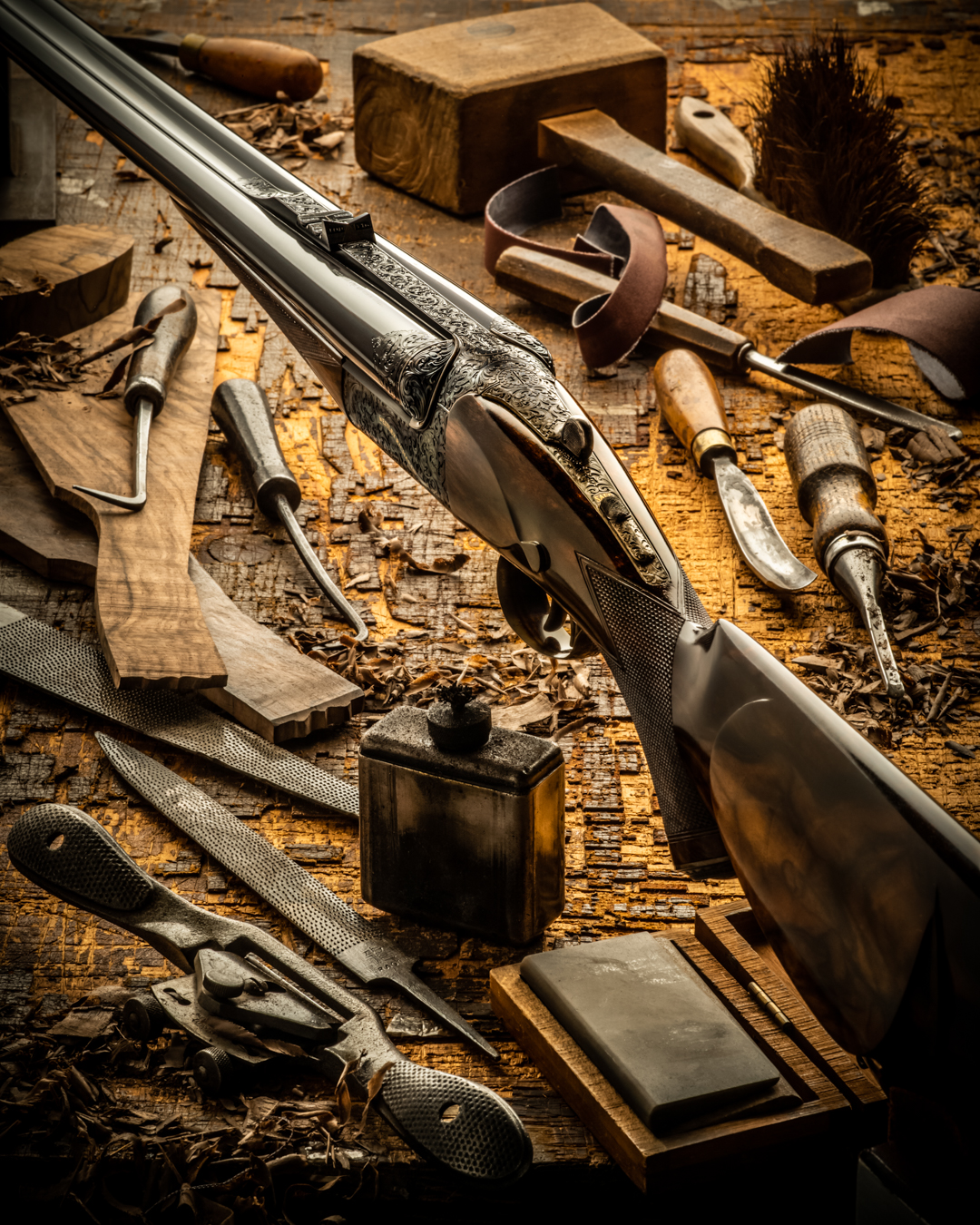
Some engraving is better suited to case colour hardening than other types. The colours can swamp fine scenes and tiny scrolls. Here, we have opted for bold, full-coverage, foliate scroll work, which elevates the beauty of the colour, rather than detracting from it. The colours and the deep scrolls combine to create a glowing, rich, textured appearance.
It also lessens the glare of sunlight on steel, which can be a hindrance to a hunter.
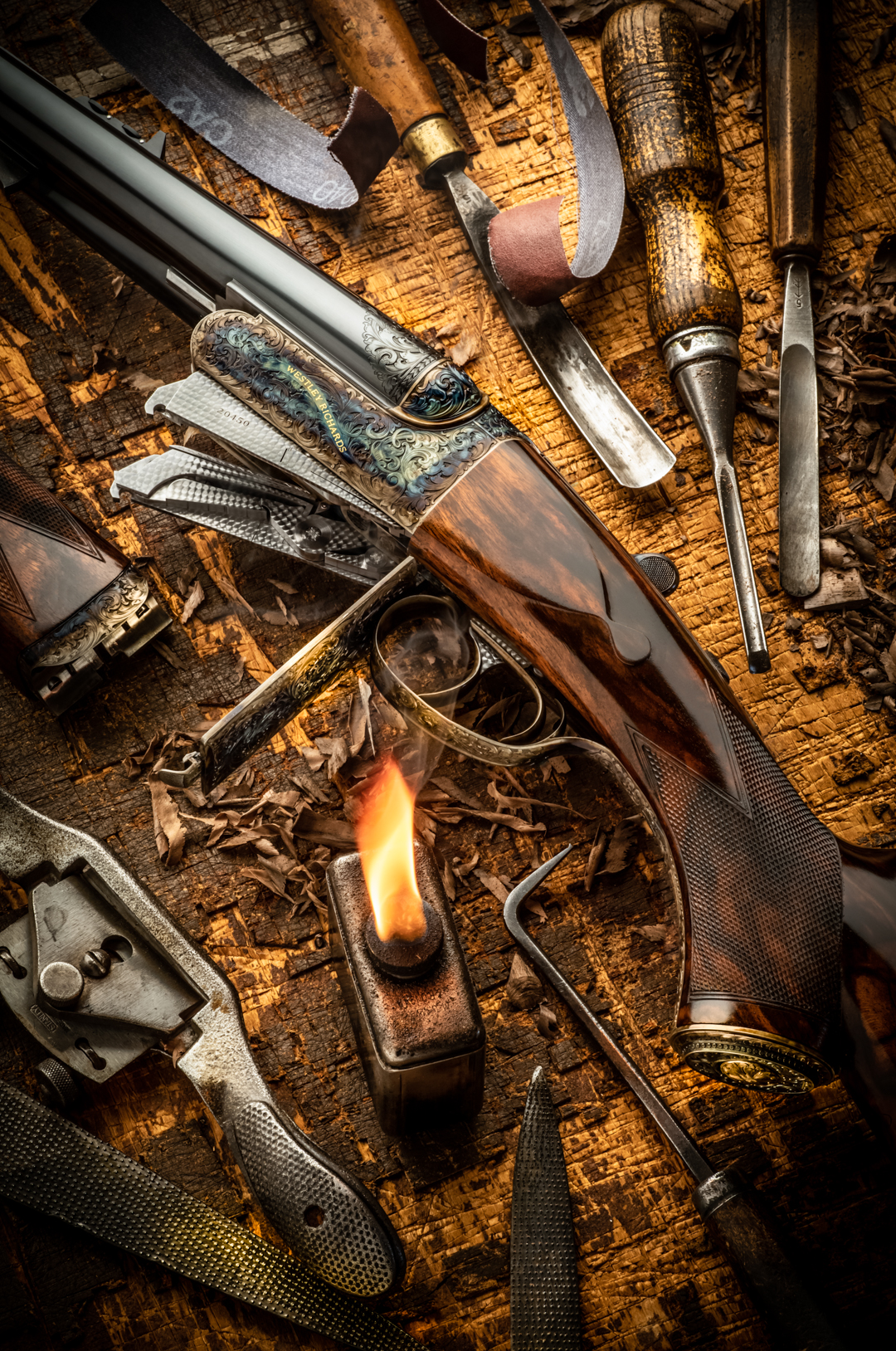
We believe quality on the inside is as, if not more, important than quality on the outside. The finish internally is as painstakingly applied as it is on the parts of the gun everyone can see.
Note the careful jeweling to the locks and the trigger blades; places many gunmakers would leave unpolished.
Additional class is illustrated in the final image, below, where we have engraved the breech-ends of the barrels and the quarter rib to match the action.The sparing use of gold is visible here, with fast-acquisition of the target promoted via the gold triangle on the ramp, which is set for 100 yard shots and the fine line to the bottom of the leaf sight 'V's for 200 and 300 yards.
The only other gold is used to highlight the serial number, 20450, on the guard strap and the company name inside its scroll banner, either side of the action.
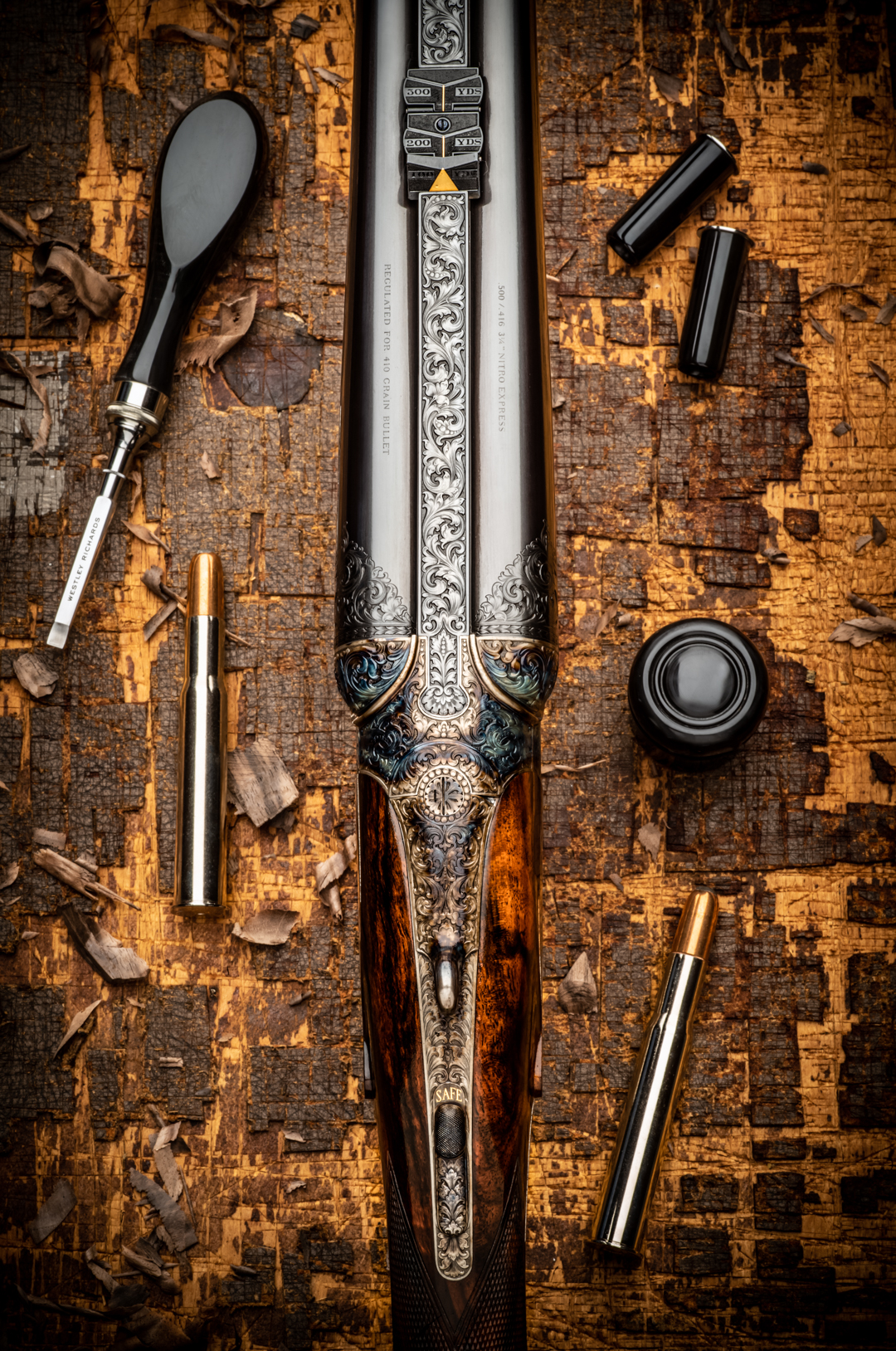
As is traditional, the cartridge and bullet weight is engraved on the barrels, so years from now, anyone considering putting it to use can see exactly what ammunition is required and will shoot to point of aim with the iron sights, as regulated here in 2024. Such information has proven invaluable to hunters today seeking to shoot rifles made a century ago.
We fully expect, and sincerely hope, that someone will be shouldering this rifle in Africa some time around 2124, whatever the world may look like then.
Whether for the discerning collector or the avid sportsman, Westley Richards firearms represent the epitome of excellence in the world of bespoke gunmaking. Known for the droplock shotgun, over and under shotgun, double barrel rifle and bolt action rifle, the company has achieved an illustrious 200 year history of innovation, craftmanship and artistry.
As part of our best gun build, clients can choose from three levels of gun engraving: the house scroll; signature game scenes; and exhibition grade masterpieces. All Westley Richards sporting arms are built at their factory in Birmingham, England.
Discover more about the gunmaking journey at our custom rifles and bespoke guns pages.












